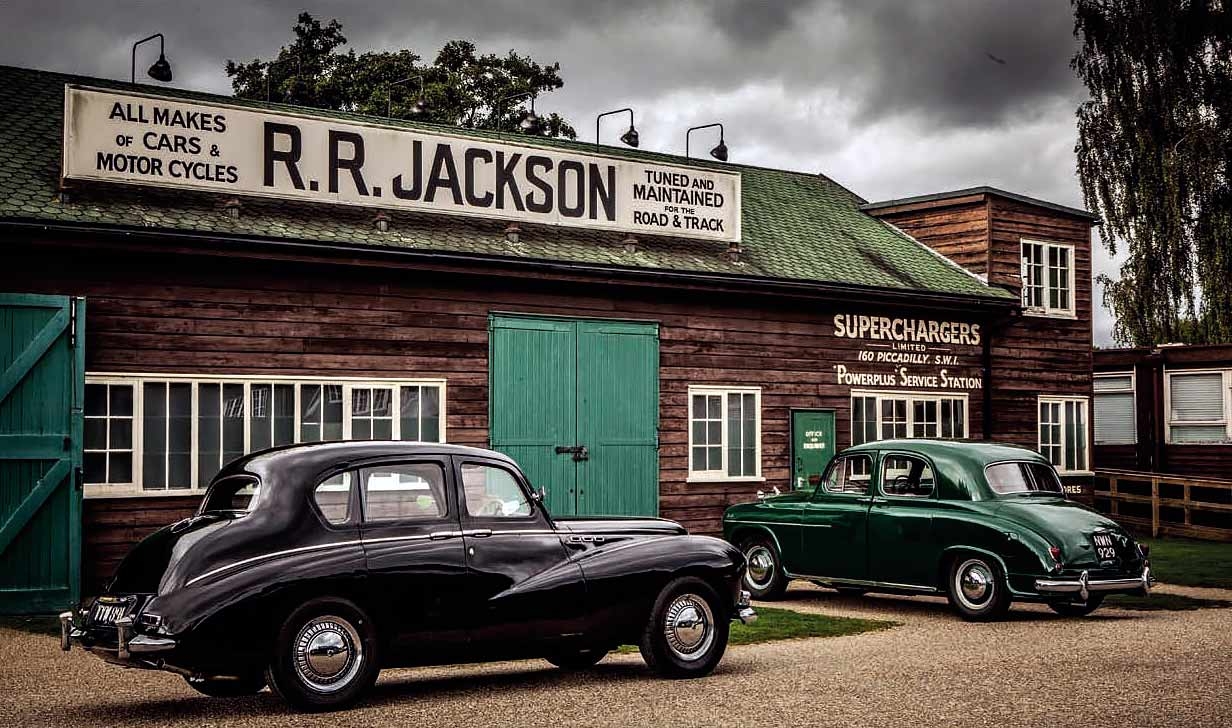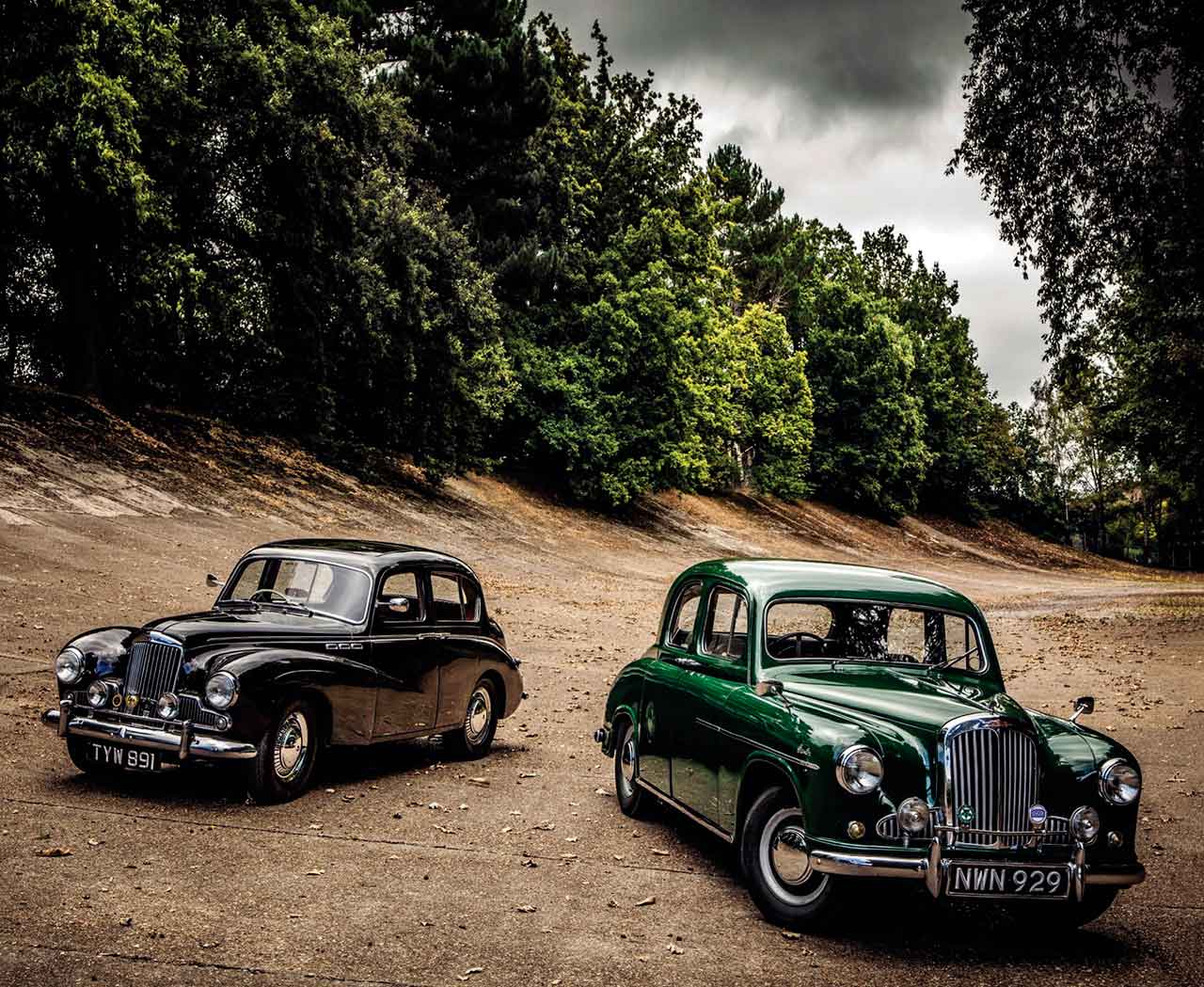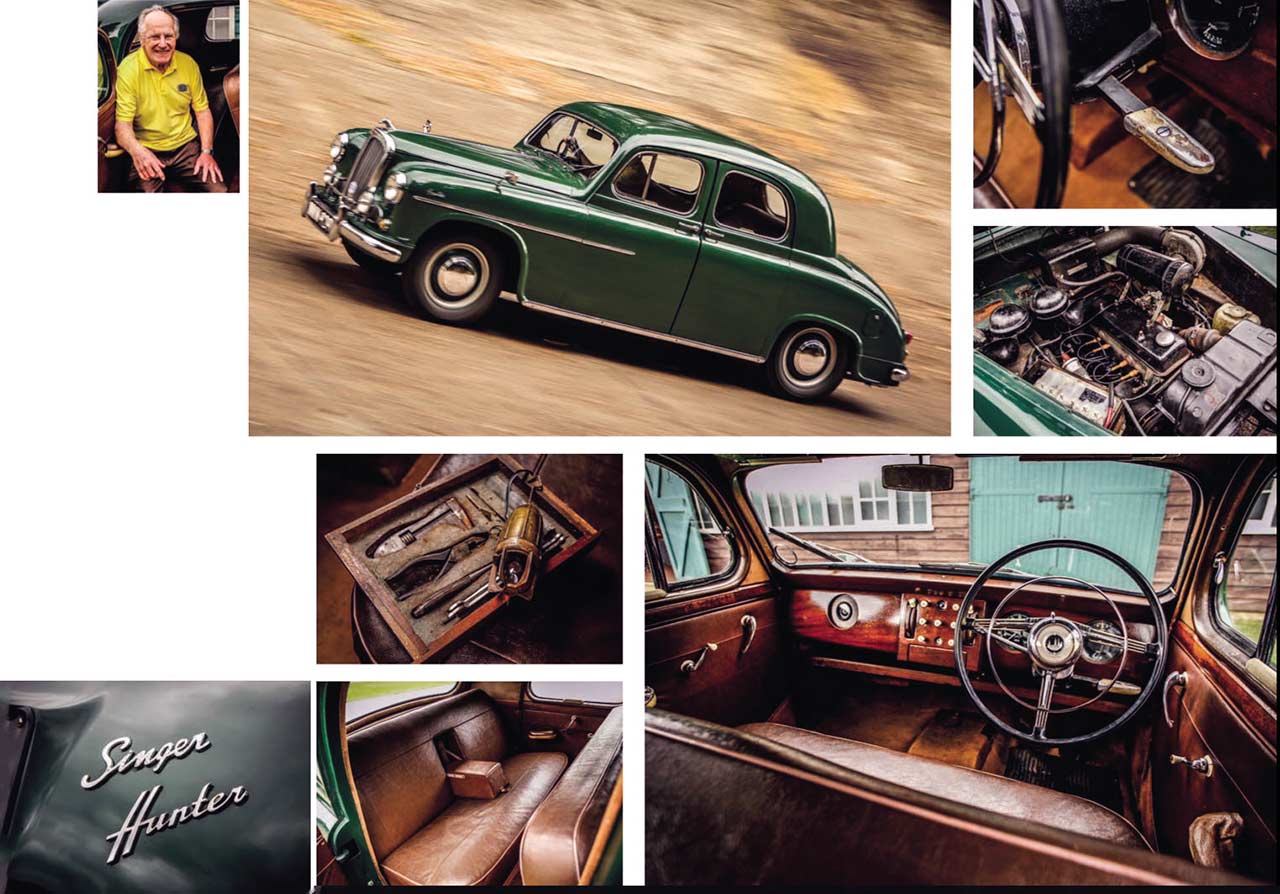
A touch of class for the post-war family saloon. No Teds please, we’re British: Singer and Sunbeam eschew jukebox glitz. The Sunbeam MkIII and Singer Hunter heralded a new age of prosperity, says Andrew Roberts, while retaining the decorum of their predecessors. Photography Tony Baker.
Singer versus Sunbeam Hunter and MkIII: for chaps not spivs
Of all the visions of past motoring, one of the most beguiling is that of the ‘gentleman’s touring car’. This era was in its twilight by the mid- 1950s, but there were still vehicles that belonged in the world of saluting AA and RAC patrolmen and John Betjeman’s Shell Guides – such as the Sunbeam MkIII and the Singer Hunter. Both were perfectly suited to the chap who regarded the Ford Zephyr or the E-series Vauxhall Cresta as little more than a Palais de Danse on wheels.

And both were the last incarnations of models that made their debut at the 1948 Motor Show. The SM1500, Singer’s first post-war design, represented a major step for the marque. Power came from a chain-driven overhead-cam engine based on the unit found in the outgoing Super 12, but the slab-sided coachwork and quasi-Detroit grille bore no resemblance to any previous model. ‘Dignity, style and perfect balance,’ claimed the adverts, although domestic customers had to add their names to a long waiting list because when full production commenced in 1949, the first examples were for ‘Export Only’.
In ’1951, the 1506cc engine was reduced in size to 1497cc and twin carburettors became available in 1952, but sales were already decreasing by then. One challenge that Singer dealers faced was that this was an expensive model by the standards of 1½-litre saloons and, as the decade progressed, its styling became more of an issue.
The coachwork was heavily influenced by the 1946 Kaiser-Frazer but, somewhat inevitably, little dates more rapidly than the British motor industry’s interpretation of US modernism. There was no budget for fresh bodywork, so the SM1500 was facelifted into the Hunter in late ’1954. It sported an upright grille with a horsehead mascot for a further touch of distinction and to dispel any last vestiges of Americana. The Singer boasted a heater, foglamps, windscreen washers and – an especially nice touch – the boot incorporated a fitted tooltray. Early models featured a glassfibre bonnet and valance to reduce weight, but those were replaced by steel panels after problems with quality control. A year later the Hunter was offered as the stripped-spec ‘S’ – sans clock, heater and auxiliary lamps – and high-performance, twin-cam 75 (few of which were produced). The Coventry factory was making just 30 cars per week and, in January 1956, the Rootes Group finalised its acquisition of the famous marque. The Gazelle, basically a rebadged ‘Audax’ Hillman Minx that was initially powered by the Singer overheadcam motor, made its debut eight months later.

The last Hunters were sold in 1957, and in ’1958 the Gazelle IIA was powered by a Hillman engine. The Hunter’s lines have been the subject of some debate, but I cannot see how it could objectively be called aesthetically challenged. The best description for ‘our’ British Racing Green car is ‘pleasingly formal’, with a profile reminiscent of the Rover P4. When the Singer was new, a select group of motorists would have regarded it as a welcome relief from the vulgarities of commercial television and burger bars. Nor did an air of reticence prevent it from enjoying cinematic stardom: a Hunter had the dubious distinction of guest-starring in Fire Maidens of Outer Space. In this 1956 British B-movie, the planet Venus bears a startling resemblance to Chobham Common and it must be said that the Singer out-acts the entire human cast.
My take on the Hunter is that it was proudly out of step with the middle-class car market. It was launched in the year that rationing ceased, yet those thick pillars and that shallow ’screen hark back to the Attlee era. The Singer appealed to a select number of drivers who appreciated engineering principles over duotone paint and chromium decorations. The cabin is almost overwhelmingly sensible, with the ambience of a bank manager’s office, and the box-section chassis gives a flat floor. There was more than enough headroom for occupants to wear a Homburg, which is entirely in keeping with a car that you could imagine as transport for a town clerk whose role model was Raymond Huntley – best known these days as the solicitor in Upstairs Downstairs.
On the road, however, the Hunter belies its sober looks. It feels heavy at low speeds and, although the column shift was not appreciated in period, it is nicer to operate than the set-up on a contemporary Austin A90 Westminster. It does not encourage swift changes – the prospect of striking one’s knuckles on the dashboard serves as a deterrent against vulgar haste – because the Singer’s watchword is ‘order’. The adverts boasted that it was a car ‘for the connoisseur who likes his spirited motoring in comfort’ and the first half of that claim seems a trifle optimistic.
The Hunter is undeniably comfortable, but it was not especially spirited – even by the standards of c60 years ago. Two of its main selling points were refinement and ride quality, ‘our’ Singer taking the vicissitudes of Brooklands’ road surfaces in its stride. The engine is phenomenally flexible, and it is as equally suited to gentle perambulating through leafy suburban lanes to the nearest Lyons’ Corner House as it is to cruising along a trunk road at an unstressed 60mph.
As for the Sunbeam, it is more flamboyant than the Singer, yet never gaudy. It was ‘Impeccably correct for City business or West End shopping’ according to Rootes, with a brilliant tagline that effortlessly combined snobbery with social insecurity. In fact, the MkIII has the agreeably raffish character of a car that Terry-Thomas, Nigel Patrick or any other prime British cinematic cad would be delighted to own. It also had an excellent competition pedigree, from George Murray-Frame’s 90 Mk1 winning the Coupe des Alpes on the 1948 Alpine Rally to Stirling Moss’ Coupe d’Or in ’1952 and Per Malling driving a MkIII to outright victory on the 1955 Monte. Even now, it is almost impossible to look at this handsome car and not think of black-and-white newsreel footage and triumphant-sounding announcers proclaiming the name of Sunbeam.
The Hunter and the MkIII are both fitted with suicide rear doors, yet while the Singer seems redolent of ‘Export or Die’, the Sunbeam’s dashing appearance belongs to the late 1930s. In profile, it suggests pre-war affluent suburbia with mock-Tudor villas and trips to a fashionable roadhouse on the Kingston bypass, yet its lines masked Rootes’ constant evolution of the range.
By 1950, the slow-selling 1.2-litre 80 had been discontinued and the 90 MkII had independent front suspension, a stronger chassis and its 1994cc motor was replaced by a 2.3-litre unit that was based on the Humber Hawk’s engine. The MkIIA of 1952 had no rear spats, while two years later the MkIII lost its Talbot suffix and offered greater power thanks to a higher-compression cylinder head that was originally developed for the Alpine. By then it had three portholes in the front wings and, for any owner who wanted to cut a dash at Goodwood, a range of optional duotone paint finishes. Production stopped in 1957, by which time Sunbeam’s marketing focus was on the Rapier.
As befitting a car that cost £1100-plus, the MkIII is exceptionally well-appointed, with two welcome items of equipment for the larger than average driver – the multi-adjustable front seats and the sliding roof. While the Singer has space for the driver to sit (but never slouch) on its front bench, the cabin of the Sunbeam feels remarkably compact although opening the top helps to alleviate any sense of claustrophobia. The fascia has a splendid Art Deco appearance and most owners would gladly have forked out an extra £7 10s for a tachometer that was apparently designed to be read by the driver’s left kneecap.
And the Sunbeam truly merits a rev counter, because it performs with such verve as to sometimes make you doubt that you are behind the wheel of a car of more than 60 years old. The transmission has nicely judged ratios, although the ’box disapproves of any hurried movement of the column shift, while the MkIII’s handling genuinely belies its age. If the Hunter is cut out for trundling along country lanes, the Sunbeam positively darts through tight bends.
In its August 1955 issue, Motor Sport observed ‘handling characteristics of steering-understeer and absence of severe rolling’, which perfectly summarises the appeal of this effective sports saloon. After a few miles, you forget that you are piloting a car with strong pre-war overtones because it feels like a racy 1960s machine. The Sunbeam is not perhaps as suited to providing smart urban transport as the Singer but, with the optional overdrive, it is the perfect five-seater grand tourer, one in which ‘comfort and “rally reliability” keep spirits high, fatigue away’.
It is sometimes difficult to believe that the Singer and the Sunbeam ceased production the year before Britain’s first motorway was opened, and only two years ahead of the Mini’s debut. Yet both were above the mere vagaries of style because they embody a very old-fashioned word, ‘integrity’. The sheer quality and attention to detail in the Hunter is palpable and its lack of commercial success was quite possibly due to it not being in accord with the growing consumer trend of ‘live now, pay later’. By the late 1950s, too few motorists were prepared to look beyond those by-then very dated looks and, after Singer became a part of the Rootes empire, the potential of the brand was never properly exploited.
Certainly, the Gazelle drophead is one of the most charming convertibles of its day and the Imp-based Chamois Coupé and Sport were in the great tradition of the 1939 Nine Roadster, but the illustrious name was otherwise badge-engineered into oblivion. Its demise in 1970 was no great shock to most industry watchers and, in a sadly ironic twist of fate, the final Gazelles and Vogues were just lightly modified versions of a Hillman that had inherited the Hunter name.
Meanwhile, the MkIII is magnificent proof that mass-production and an individualistic saloon of real distinction may not be mutually exclusive, yet it also marked the swansong for a genre of vehicle. After 1957 the Rootes Group never really entered this market again, for the Sunbeam Rapier was aimed at a different form of driver – the chartered accountant with a club blazer and Mike Hawthorn flat cap, as opposed to a lounge lizard with a pencil moustache. Another factor was that the firm lacked the resources to develop a rival to the compact Jags and, by 1963, with the debuts of the Rover P6 and Triumph 2000, this gap in the line-up seemed more acute.
That same year brought the introduction of the original Humber Sceptre, a car that was not so far removed from the Sunbeam-Talbot tradition, but by that time Rootes’ financial issues meant that it was never properly developed.
For my own part, I would have each of these cars occupy my driveway because the Singer and the Sunbeam represent different but complementary aspects of post-war motoring. The Singer Hunter would be used for the weekdays, arriving at the office with a quiet sense of dignity, while the Sunbeam is emphatically a weekend vehicle for jaunts to Brighton or to the races. If only those patrolmen were still around to salute on your trip back to a sepia-tinted past.
Thanks to Alan Rudge, Singer Owners’ Club: www.singerownersclub.co.uk; Association of Singer Car Owners: www.asco.org.uk; Peter Rodd, Sunbeam-Talbot Owners’ Club: sunbeamtalbotownersclub.co.uk; everyone at Brooklands: www.brooklandsmuseum.com

TECHNICAL DATA FILE SPECIFICATIONS SINGER HUNTER
Sold/number built 1954-’1956/4750
Construction steel chassis, steel body
Engine all-iron, sohc 1497cc ‘four’, single carb; 48bhp @ 4200rpm; 79lb ft @ 2400rpm
Transmission four-speed manual, RWD
Suspension: front independent, by double wishbones, coil springs, anti-roll bar rear live axle, semi-elliptic leaf springs
Steering recirculating ball
Brakes drums
Length 14ft 9in (4496mm)
Width 5ft 3in (1600mm)
Height 5ft 4in (1626mm)
Weight 2520lb (1143kg)
0-60mph 26.3 secs
Top speed 74mph
Price new £975
Price now £6000
‘BOTH WERE ABOVE THE MERE VAGARIES OF STYLE – THEY ARE THE EMBODIMENT OF INTEGRITY’

TECHNICAL DATA FILE SPECIFICATIONS SUNBEAM MkIII
Sold/number built 1954-’1957/c2250
Construction steel chassis, steel body
Engine all-iron, ohv 2267cc ‘four’, single carb; 80bhp @ 4400rpm; 122lb ft @ 2400rpm
Transmission four-speed manual, RWD
Suspension: front independent, by double wishbones, coil springs, anti-roll bar rear live axle, semi-elliptic leaf springs
Steering recirculating ball
Brakes drums
Length 14ft (4267mm)
Width 5ft 2 ½ in (1586mm)
Height 4ft 11in (1499mm)
Weight 2950lb (1338kg)
0-60mph 17.4 secs
Top speed 95mph
Price new £1127
Price now £7500





